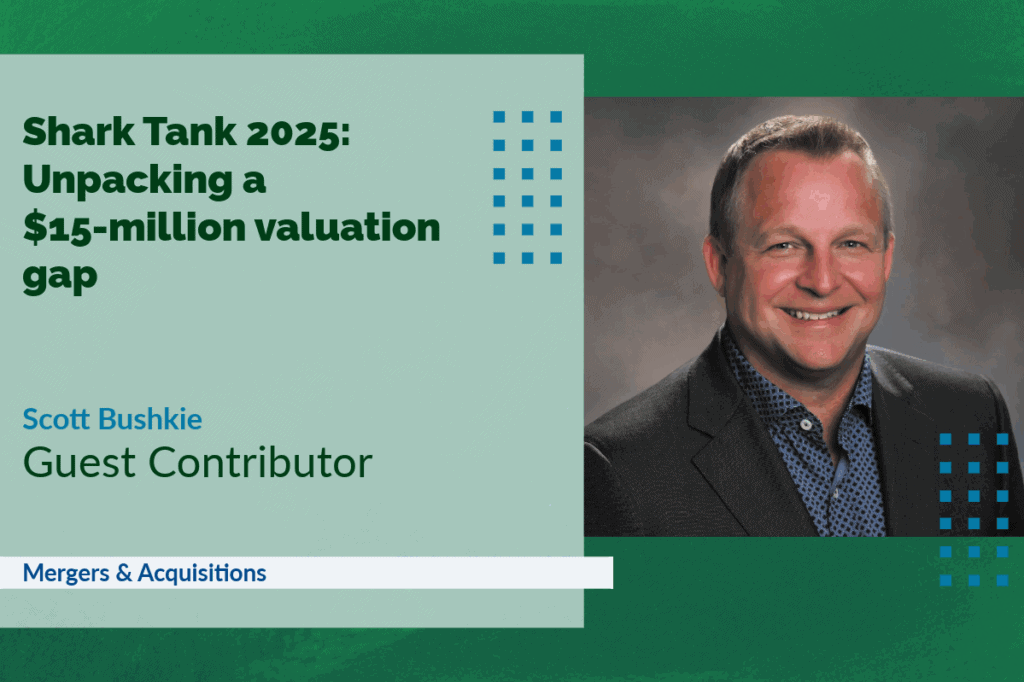
June 30, 2025
During this year’s Cornerstone Business Services’ State of M&A Conference, we organized our own local “shark tank” event.
We invited four private equity firms to review and submit an offer on a real-world company, peeling back the curtain on how they arrive at their valuations and deal structures.
This year’s subject was a company specializing in mission-critical lighting products – think essential lights on cell towers, tall buildings and subway systems – that actually sold a few years prior.
For the sake of the program, we anonymized details and shifted dates, presenting a company with $15 million revenue in 2023, $19.5 million in 2024 ($3.4 million adjusted EBITDA) and a projected $22 million revenue for 2025.
The core question: How would different buyers value the same opportunity, especially in a market teeming with capital?
The answers, as always, were illuminating.
Offer #1
As the offers were revealed, the lowest one came in at $18 million.
At an estimated 4.5 multiple of the trailing 12 months EBITDA, this represented the most conservative valuation.
This family investment firm had no strategic synergies in its portfolio, making it a standalone investment for them.
Offers #2 and #3
The next two offers both circled around $25.5 million but came with different deal structures. One proposed 80% cash at close, with a 10% seller note and 10% equity rollover.
The other offered all cash at close, plus an equity pool for management to sweeten the deal. These firms projected a hold period of three to seven years before they would re-trade the business and recoup their investment.
Offer #4
The final offer came in at $33 million, all cash at close.
This offer – a full $15 million above the lowest bid – understandably turned heads.
How could one buyer see so much more value?
The firm behind the $33 million offer wasn’t just buying a company – they were executing a strategic masterstroke.
They already had a platform company in the engineered lighting space, making this acquisition a perfect add-on.
Crucially, the buyer’s existing platform company had a customer concentration of 30%.
Acquiring this new, diversified business would slash that concentration to 18%, immediately warranting a higher multiple.
Notably, this buyer had already been in the platform business for four years, so they expected a hold period of just two to three years on this new acquisition before they’d look to exit the combined operation.
The shark tank event proves a point: Buyers can see the exact same information and come up with significantly different valuations and structures.
The highest bidder here was willing to pay for clear, actionable synergies, because they weren’t just buying a standalone business, they were enhancing a larger strategic vision.
The broader view: Why such disparities exist
The spread from $18 million to $33 million isn’t an anomaly – it’s a reflection of today’s market.
There continues to be a record amount of money available – nearly $2.5 trillion in private equity dry powder, according to some estimates.
This abundance of capital and eagerness to invest drives diverse buyer behaviors:
The cautious buyer
As seen in the lowest offer, some are wary, perhaps due to past setbacks or because they don’t see clear synergies.
Remember, no one is buying a business to maintain the status quo.
The financial buyer
The mid-range offers often reflect a pure financial play, focusing on the standalone value and a plan to grow it with new capital and expertise.
The strategic buyer
These are the game-changers.
They might be a company looking to grow through acquisition or a private equity firm with a large war chest aggressively consolidating an industry.
Even though they are paying strong multiples for these companies, the ultimate multiple that the whole company will sell for will still be significantly higher.
The pressured buyer
We also see private equity firms that are really under pressure to deploy capital.
Perhaps they were more cautious through previous uncertainties and are now “up against the clock” with a 10-year fund nearing its end.
They have to take some big shots and get results or they won’t get another fund.
Navigating the marketplace
The stark difference in these offers underscores a fundamental truth: The value of your business is not a single, fixed number.
It is heavily influenced by who the buyer is, what their strategic goals are and the unique synergies they can bring.
Though one buyer might see a solid standalone operation, another might see the missing piece to a much larger puzzle, warranting a significantly higher investment.
 Hard work, determination lead self-taught baker to success, storefront
Hard work, determination lead self-taught baker to success, storefront Door County restaurant centered around farm-to-table ethics
Door County restaurant centered around farm-to-table ethics








